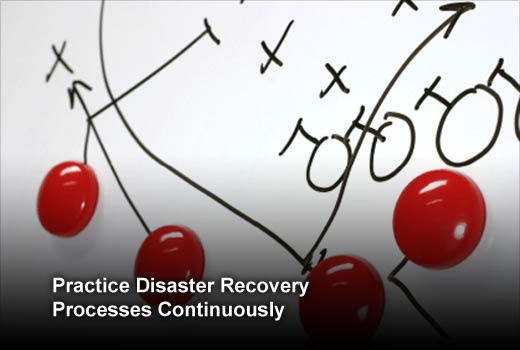With the start of the Atlantic hurricane season, the constant threat of tornadoes in the Midwest, and a looming strain on the electric grid from summer heat waves, companies must ensure that their disaster recovery strategies are rock solid and battle-tested. Downtime costs money – and a lot of it. According to the 2014 State of Global Disaster Recovery Preparedness report, the cost of losing business-critical applications to outages can be as high as $5,000 a minute. Companies can’t afford to play Russian roulette with disaster recovery and business continuity. They need to institute a plan now – before disaster strikes. And companies today no longer have an excuse for inaction. Free tools, like BC/DR Link™, are easily accessible to help companies build and customize their own disaster recovery plan so they can confidently respond to a disaster or outage and recover their systems rapidly, effectively and efficiently.
Here are seven considerations from backup and disaster recovery leader Unitrends to keep top of mind when developing a successful disaster recovery strategy.
Backup and Disaster Recovery Best Practices
Click through for seven considerations organizations should keep top of mind when developing a successful disaster recovery strategy, as identified by Unitrends.
Prioritize People – Your Most Important Asset
The first step in developing a successful disaster recovery strategy is identifying key operational personnel – those people without whom your business can’t operate – and providing them with the ability to work remotely or from a secondary location when a disaster strikes. Determine the steps that will be required to get those employees online and communicating with each other, and make sure they have quick and easy access to the business-critical data, systems, servers and other infrastructure they need to keep the business running.
Look Beyond IT
Remember to look beyond IT when identifying personnel that will have a key role in disaster situations. Examine all business functions, identify those that are critical to maintaining business continuity and develop a recovery strategy for each. Effective recovery plans apply to all critical business departments, connect the appropriate people in the right way and guide them through the process of what to do in the event of a disaster or outage.
Practice Disaster Recovery Processes Continuously
Identify key operational processes – step-by-step guidelines for who does what in the event of a disaster – and make sure employees are aware of and have practiced their role. Remember to consider every process that is critical to the daily operations of your business, not just IT practices. People, processes and technology change and evolve so often that it’s important to schedule practice sessions on a continuous basis.
Make Sure Technology Takes Center Stage
Backup and replication are the foundation of any modern disaster recovery plan. Identify key operational infrastructure – data, systems, servers and applications without which your business can’t operate – and make sure they are being backed up and replicated to an offsite location. This process provides an added layer of redundancy so, in the event your primary data center goes down, critical information and systems are available via the secondary site, and business operations can proceed unaffected.
Consider the Cloud for Offsite Storage and Replication
No matter what strategy you decide to use, making sure you get copies of your data offsite every day is what’s most important when it comes to recovery. But, the cloud provides a fast, cost-effective and efficient way of storing data, systems and infrastructure and enables you to retrieve those critical assets within minutes of a declared disaster.
Define RTOs and RPOs
Recovery Time Objectives (RTOs), the amount of time a system can be down without causing too much damage, and Recovery Point Objectives (RPOs), the amount of data that your company can afford to lose from your last known backup or snapshot without severe consequences, are where it all begins from a data recovery standpoint. Work with executive management and key stakeholders to define these metrics. Everyone needs to be on the same page about what applications, functions and data are business critical, and what the loss of each in a disaster could mean in terms of revenue, brand damage and regulatory compliance. Once RPOs and RTOs are established, the rest of your disaster recovery strategies should work toward meeting these requirements.
Test, Test and Test Again
A disaster recovery plan is worthless if you don’t test it. You’ll never know if it will work when you need it to, and you don’t want to find out it has failed after a disaster has occurred. All elements of a disaster recovery plan should be tested regularly – at least once a quarter – and recovery testing should be treated as a standard business practice.
In addition to having employees practice their roles in a disaster situation, data protection technology must be tested to ensure you can recover from a disaster or outage within specified RTOs, RPOs and service level agreements (SLAs). You should also regularly review your disaster recovery plan to ensure its continued relevancy as business needs and technology requirements change. Your recovery plan should be treated as a dynamic document that is constantly modified to ensure continued effectiveness as your business evolves and grows.










